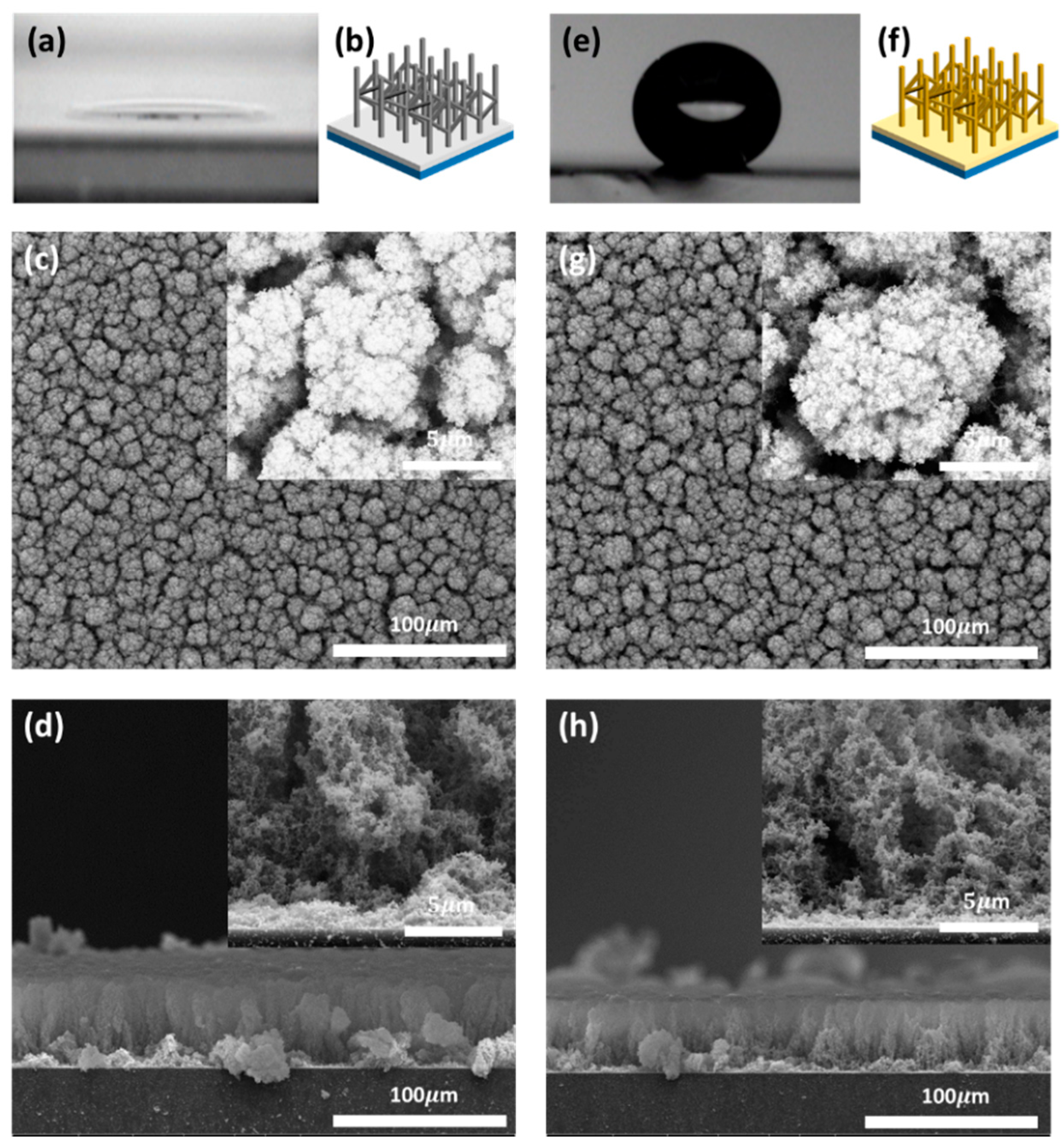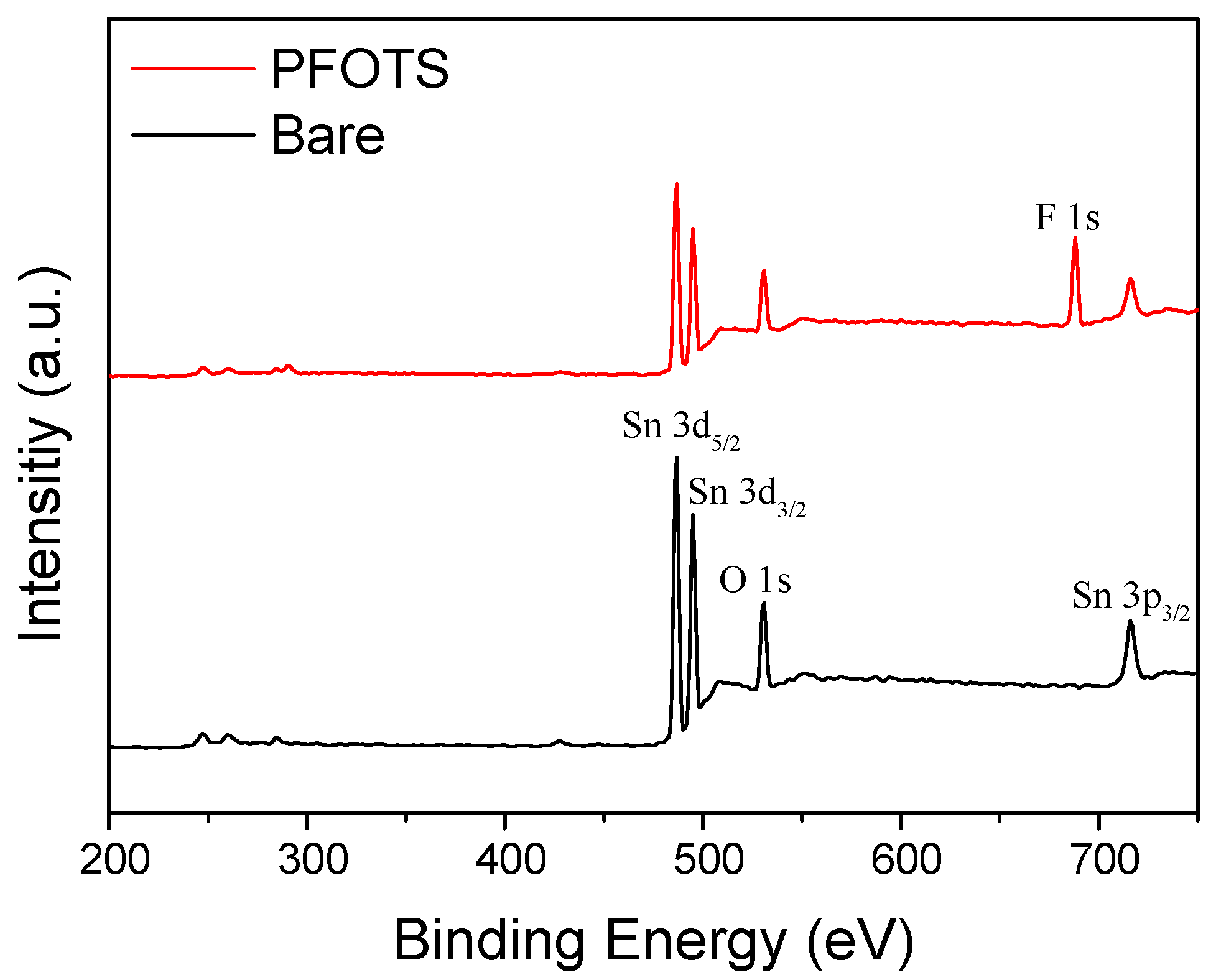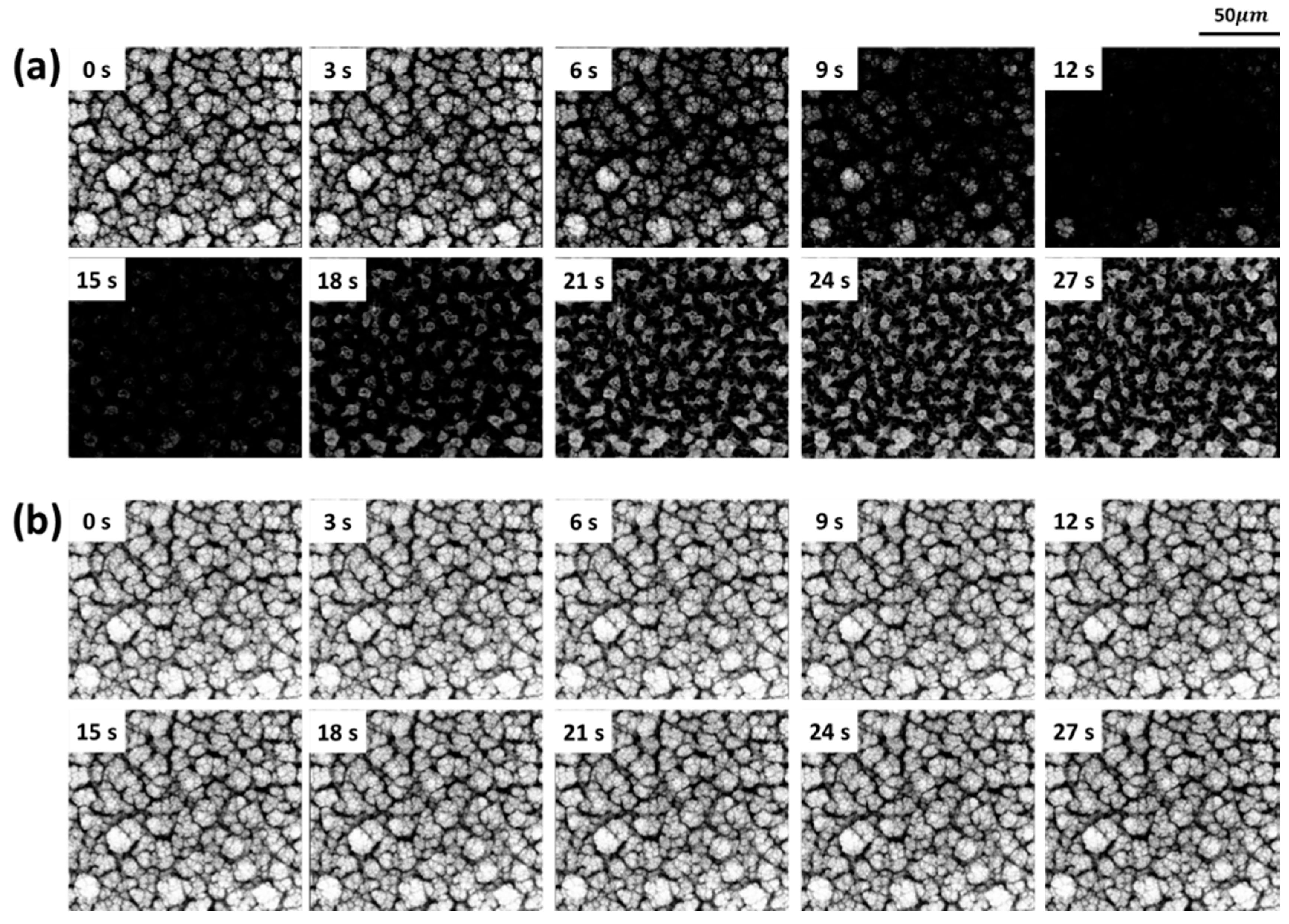Self-Assembled Monolayers Coated Porous SnO2 Film Gas Sensor with Reduced Humidity Influence
Abstract
:1. Introduction
2. Materials and Methods
2.1. Preparation of the Porous SnO2
2.2. SnO2 Coating Method of SAMs on Porous SnO2 Films
2.3. Surface Analysis
2.4. Gas Sensing Measurement
3. Results and Discussion
4. Conclusions
Supplementary Materials
Author Contributions
Funding
Institutional Review Board Statement
Informed Consent Statement
Conflicts of Interest
References
- Wang, C.; Yin, L.; Zhang, L.; Xiang, D.; Gao, R. Metal Oxide Gas Sensors: Sensitivity and Influencing Factors. Sensors 2010, 10, 2088–2106. [Google Scholar] [CrossRef] [PubMed] [Green Version]
- Kim, H.-J.; Lee, J.-H. Highly sensitive and selective gas sensors using p-type oxide semiconductors: Overview. Sens. Actuators B Chem. 2014, 192, 607–627. [Google Scholar] [CrossRef]
- Degler, D.; Weimar, U.; Barsan, N. Current Understanding of the Fundamental Mechanisms of Doped and Loaded Semi-conducting Metal-Oxide-Based Gas Sensing Materials. ACS Sens. 2019, 4, 2228–2249. [Google Scholar] [CrossRef] [PubMed]
- Han, M.A.; Kim, H.-J.; Lee, H.C.; Park, J.-S.; Lee, H.-N. Effects of porosity and particle size on the gas sensing properties of SnO2 films. Appl. Surf. Sci. 2019, 481, 133–137. [Google Scholar] [CrossRef]
- Suematsu, K.; Ma, N.; Watanabe, K.; Yuasa, M.; Kida, T.; Shimanoe, K. Effect of Humid Aging on the Oxygen Adsorption in SnO2 Gas Sensors. Sensors 2018, 18, 254. [Google Scholar] [CrossRef] [Green Version]
- Heilig, A.; Barsan, N.; Weimar, U.; Heilig, A. Selectivity enhancement of SnO2 gas sensors: Simultaneous monitoring of resistances and temperatures. Sens. Actuators B Chem. 1999, 58, 302–309. [Google Scholar] [CrossRef]
- Gao, H.; Wei, D.; Lin, P.; Liu, C.; Sun, P.; Shimanoe, K.; Yamazoe, N.; Lu, G. The design of excellent xylene gas sensor using Sn-doped NiO hierarchical nanostructure. Sens. Actuators B Chem. 2017, 253, 1152–1162. [Google Scholar] [CrossRef]
- Thu, N.T.A.; Cuong, N.D.; Nguyen, L.C.; Khieu, D.Q.; Nam, P.C.; Van Toan, N.; Hung, C.M.; Van Hieu, N. Fe2O3 nanoporous network fabricated from Fe3O4/reduced graphene oxide for high-performance ethanol gas sensor. Sens. Actuators B Chem. 2018, 255, 3275–3283. [Google Scholar] [CrossRef]
- Xu, S.; Sun, F.; Gu, F.; Zuo, Y.; Zhang, L.; Fan, C.; Yang, S.; Li, W. Photochemistry-Based Method for the Fabrication of SnO2 Monolayer Ordered Porous Films with Size-Tunable Surface Pores for Direct Application in Resistive-Type Gas Sensor. ACS Appl. Mater. Interfaces 2014, 6, 1251–1257. [Google Scholar] [CrossRef]
- Li, Y.-X.; Guo, Z.; Su, Y.; Jin-Huai, L.; Tang, X.-H.; Huang, J.-R.; Huang, X.-J.; Li, M.-Q.; Liu, J. Hierarchical Morphology-Dependent Gas-Sensing Performances of Three-Dimensional SnO2 Nanostructures. ACS Sens. 2016, 2, 102–110. [Google Scholar] [CrossRef]
- Liu, Y.; Koep, A.E.; Liu, M. A Highly Sensitive and Fast-Responding SnO2 Sensor Fabricated by Combustion Chemical Vapor Deposition. Chem. Mater. 2005, 17, 3997–4000. [Google Scholar] [CrossRef]
- Dai, Z.R.; Pan, Z.; LinWangabc, Z. Growth and Structure Evolution of Novel Tin Oxide Diskettes. J. Am. Chem. Soc. 2002, 124, 8673–8680. [Google Scholar] [CrossRef] [PubMed]
- Park, N.-K.; Lee, S.Y.; Lee, T.J. Application of ZnO single-crystal wire grown by the thermal evaporation method as a chemical gas sensor for hydrogen sulfide. J. Nanosci. Nanotechnol. 2011, 11, 614–618. [Google Scholar] [CrossRef] [PubMed]
- Van Hieu, N.; Van Vuong, H.; Van Duy, N.; Hoa, N.D. A morphological control of tungsten oxide nanowires by thermal evaporation method for sub-ppm NO2 gas sensor application. Sens. Actuators B Chem. 2012, 171–172, 760–768. [Google Scholar] [CrossRef]
- Dolbec, R.; El Khakani, M.; Serventi, A.; Saint-Jacques, R. Influence of the nanostructural characteristics on the gas sensing properties of pulsed laser deposited tin oxide thin films. Sens. Actuators B Chem. 2003, 93, 566–571. [Google Scholar] [CrossRef]
- Iizuka, K.; Kambara, M.; Yoshida, T. Highly sensitive SnO2 porous film gas sensors fabricated by plasma spray physical vapor deposition. Sens. Actuators B Chem. 2012, 173, 455–461. [Google Scholar] [CrossRef]
- Kim, T.S.; Kim, Y.B.; Yoo, K.S.; Sung, G.S.; Jung, H.J. Sensing characteristics of dc reactive sputtered WO3 thin films as an NOx gas sensor. Sens. Actuators B Chem. 2000, 62, 102–108. [Google Scholar] [CrossRef]
- Wang, C.; Cui, X.; Liu, J.; Zhou, X.; Cheng, X.; Sun, P.; Hu, X.; Li, X.; Zheng, J.; Lu, G. Design of Superior Ethanol Gas Sensor Based on Al-Doped NiO Nanorod-Flowers. ACS Sens. 2016, 1, 131–136. [Google Scholar] [CrossRef]
- Yi, S.; Tian, S.; Zeng, D.; Xu, K.; Peng, X.; Wang, H.; Zhang, S.; Xie, C. A novel approach to fabricate metal oxide nanowire-like networks based coplanar gas sensors array for enhanced selectivity. Sens. Actuators B Chem. 2014, 204, 351–359. [Google Scholar] [CrossRef]
- Choi, Y.; Hwang, I.-S.; Park, J.-G.; Lee, J.-H. Novel fabrication of a SnO2 nanowire gas sensor with high sensitivity. Nanotechnology 2008, 19, 095508. [Google Scholar] [CrossRef]
- Zou, Y.; Chen, S.; Sun, J.; Liu, J.; Zhang, Y.; Liu, X.; Zhang, J.; Yang, D. Highly Efficient Gas Sensor Using a Hollow SnO2 Microfiber for Triethylamine Detection. ACS Sens. 2017, 2, 897–902. [Google Scholar] [CrossRef] [PubMed]
- Comini, E.; Faglia, G.; Sberveglieri, G.; Pan, Z.; Wang, Z.L. Stable and highly sensitive gas sensors based on semiconducting oxide nanobelts. Appl. Phys. Lett. 2002, 81, 1869–1871. [Google Scholar] [CrossRef]
- Lee, J.-H. Gas sensors using hierarchical and hollow oxide nanostructures: Overview. Sens. Actuators B Chem. 2009, 140, 319–336. [Google Scholar] [CrossRef]
- Moon, W.J.; Yu, J.H.; Choi, G.M. Selective Gas Detection of SnO2-TiO2 Gas Sensors. J. Electroceram. 2004, 13, 707–713. [Google Scholar] [CrossRef]
- Kim, H.-R.; Choi, K.-I.; Kim, K.-M.; Kim, I.-D.; Cao, G.; Lee, J.-H. Ultra-fast responding and recovering C2H5OH sensors using SnO2 hollow spheres prepared and activated by Ni templates. Chem. Commun. 2010, 46, 5061–5063. [Google Scholar] [CrossRef] [PubMed]
- Bhati, V.S.; Ranwa, S.; Rajamani, S.; Kumari, K.; Raliya, R.; Biswas, P.; Kumar, M. Improved Sensitivity with Low Limit of Detection of a Hydrogen Gas Sensor Based on RGO-Loaded Ni-Doped ZnO Nanostructures. ACS Appl. Mater. Interfaces 2018, 10, 11116–11124. [Google Scholar] [CrossRef] [PubMed]
- Parret, F.; Ménini, P.; Martinez, A.; Soulantica, K.; Maisonnat, A.; Chaudret, B. Improvement of micromachined SnO2 gas sensors selectivity by optimised dynamic temperature operating mode. Sens. Actuators B 2006, 118, 276–282. [Google Scholar] [CrossRef]
- Willa, C.; Schmid, A.; Briand, D.; Yuan, J.; Koziej, D. Lightweight, Room-Temperature CO2 Gas Sensor Based on Rare-Earth Metal-Free Composites—An Impedance Study. ACS Appl. Mater. Interfaces 2017, 9, 25553–25558. [Google Scholar] [CrossRef] [Green Version]
- Suematsu, K.; Sasaki, M.; Ma, N.; Yuasa, M.; Shimanoe, K. Antimony-Doped Tin Dioxide Gas Sensors Exhibiting High Stability in the Sensitivity to Humidity Changes. ACS Sens. 2016, 1, 913–920. [Google Scholar] [CrossRef]
- Masayoshi, Y.; Suematsu, K.; Yuasa, M.; Kida, T.; Shimanoe, K. Effect of Water Vapor on Pd-Loaded SnO2 Nanoparticles Gas Sensor. ACS Appl. Mater. Interfaces 2015, 7, 5863–5869. [Google Scholar] [CrossRef]
- Hijazi, M.; Rieu, M.; Stambouli, V.; Tournier, G.; Viricelle, J.-P.; Pijolat, C. Ambient temperature selective ammonia gas sensor based on SnO2-APTES modifications. Sens. Actuators B Chem. 2018, 256, 440–447. [Google Scholar] [CrossRef]
- Flink, S.; Van Veggel, F.C.J.M.; Reinhoudt, D.N. Sensor Functionalities in Self-Assembled Monolayers. Adv. Mater. 2000, 12, 1315–1328. [Google Scholar] [CrossRef]
- Angst, D.L.; Simmons, G.W. Moisture absorption characteristics of organosiloxane self-assembled monolayers. Langmuir 1991, 7, 2236–2242. [Google Scholar] [CrossRef]
- Ji, S.; Ramadhianti, P.A.; Nguyen, T.-B.; Kim, W.; Lim, H. Simple fabrication approach for superhydrophobic and superoleo-phobic Al surface. Microelectron. Eng. 2013, 111, 404–408. [Google Scholar] [CrossRef]
- Sugimura, H.; Hozumi, A.; Kameyama, T.; Takai, O. Organosilane selfassembled monolayers formed at the vapor/solid in-terface. Surf. Interface Anal. 2002, 34, 556–564. [Google Scholar] [CrossRef]
- Moon, C.S.; Kim, H.-R.; Auchterlonie, G.; Drennan, J.; Lee, J.-H. Highly sensitive and fast responding CO sensor using SnO2 nanosheets. Sens. Actuators B Chem. 2008, 131, 556–564. [Google Scholar] [CrossRef]
- Cho, Y.; Lee, H.R.; Jeong, A.; Lee, J.; Lee, S.M.; Joo, S.H.; Kwak, S.K.; Oh, J.H.; Yang, C. Understanding of Fluorination Dependence on Electron Mobility and Stability of Naphthalenediimide-Based Polymer Transistors in Environment with 100% Relative Humidity. ACS Appl. Mater. Interfaces 2019, 11, 40347–40357. [Google Scholar] [CrossRef]
- Duan, T.; Babics, M.; Seitkhan, A.; Firdaus, Y.; Liang, R.-Z.; Cruciani, F.; Liu, S.; Lopatin, S.; Beaujuge, P.M. F-Substituted ol-igothiophenes serve as nonfullerene acceptors in polymer solar cells with open-circuit voltages > 1 V. J. Mater. Chem. A 2018, 6, 9368–9372. [Google Scholar] [CrossRef]






Publisher’s Note: MDPI stays neutral with regard to jurisdictional claims in published maps and institutional affiliations. |
© 2021 by the authors. Licensee MDPI, Basel, Switzerland. This article is an open access article distributed under the terms and conditions of the Creative Commons Attribution (CC BY) license (http://creativecommons.org/licenses/by/4.0/).
Share and Cite
Lee, C.; Oh, S.; Park, S.-C.; Lee, H.-N.; Kim, H.-J.; Lee, J.; Lim, H. Self-Assembled Monolayers Coated Porous SnO2 Film Gas Sensor with Reduced Humidity Influence. Sensors 2021, 21, 610. https://doi.org/10.3390/s21020610
Lee C, Oh S, Park S-C, Lee H-N, Kim H-J, Lee J, Lim H. Self-Assembled Monolayers Coated Porous SnO2 Film Gas Sensor with Reduced Humidity Influence. Sensors. 2021; 21(2):610. https://doi.org/10.3390/s21020610
Chicago/Turabian StyleLee, Cheonji, Sunjong Oh, Seung-Chul Park, Ho-Nyun Lee, Hyun-Jong Kim, Jinkee Lee, and Hyuneui Lim. 2021. "Self-Assembled Monolayers Coated Porous SnO2 Film Gas Sensor with Reduced Humidity Influence" Sensors 21, no. 2: 610. https://doi.org/10.3390/s21020610
APA StyleLee, C., Oh, S., Park, S.-C., Lee, H.-N., Kim, H.-J., Lee, J., & Lim, H. (2021). Self-Assembled Monolayers Coated Porous SnO2 Film Gas Sensor with Reduced Humidity Influence. Sensors, 21(2), 610. https://doi.org/10.3390/s21020610





